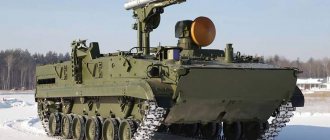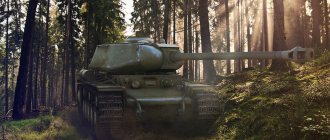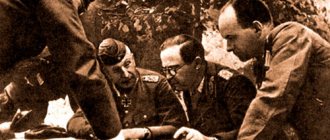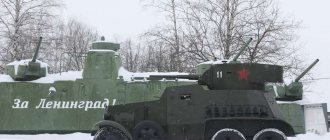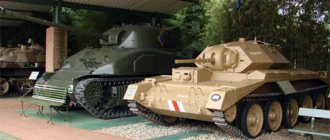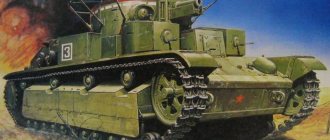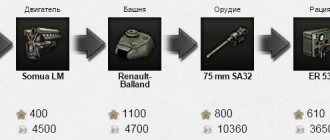Home » Real story » Little-known and unrealized projects of tanks and other armored vehicles » Projects of medium and heavy tanks in Poland (1937-1939)
Little-known and unrealized projects of tanks and other armored vehiclesUnrealized projects of tanks from other countries
youROKer 05/03/2020 3584 120
14
in Favoritesin Favoritesfrom Favorites 9
Anyone interested in the history of Polish tank building knows that before World War II, several types of wedges and one type of light tank were produced in series in Poland - 7TR . However, in the 1930s, Polish designers developed armored vehicles for various purposes. Infantry support tank (9TR), wheeled-tracked tank (10TR), cruising tank (14TR), amphibious tank ( 4TR ). But, in addition to this, in the second half of the 1930s, the Polish Armament Directorate decided to create first medium and then heavy tanks for the army. These unrealized programs will be discussed. When writing about Polish medium/heavy tanks, they often use the indices 20TR, 25TR, 40TR and others. Let us immediately make a reservation that these indices were constructed by researchers according to the 7TP (7-Tonowy Polski) type, but in reality the projects did not have such an alphanumeric designation.
A rough drawing of one of the BBT medium tank variants. Br. Panc.
Program “Czołg średni” (1937 – 1942).
In the mid-1930s, the command of the Polish army came to the conclusion that it was necessary to develop a medium tank for the Polish Army, which could solve not only infantry escort tasks (for which the 7TP tanks and TKS ), but also as a breakthrough tank, and also for the destruction of fortified points.
The program was adopted in 1937 under the simple name “Czołg średni” (“medium tank”). The Armaments Committee (KSUST) determined the initial parameters of the technical specifications, inviting the designers to focus on the project of the English medium tank A6 (Vickers 16 t.), also mentioning that such a tank is in service with the “probable enemy” - the USSR (T-28). An additional incentive for the Polish military leadership to develop their own medium tank was intelligence information about the start of production of Nb.Fz tanks in Germany. Accordingly, the Polish “Czołg średni” had to, at a minimum, correspond to the A6 and T-28 (these tanks were considered equivalent by the Poles) in technical parameters, not be inferior in strength to the Nb.Fz., and ideally surpass them. Specialists from the Artillery Directorate of the Polish Army proposed using a 75-mm gun of the 1897 model as the main armament. The weight of the designed tank was initially limited to 16–20 tons, but later the limit was increased to 25 tons.
Comparison of the size of the medium tank of the KSUST project with the “probable opponents” T-28 and Nb.Fz.
The program itself was designed for 5 years - until 1942, when, according to the plan of the Polish command, the army was supposed to receive a sufficient number of serial medium tanks.
The development of the tank was entrusted to leading Polish engineering firms under the general leadership of the Armament Committee.
The first projects were ready by 1938 - these were the developments of designers who worked in the committee itself (KSUST 1 option) and option. proposed by Biuro Badan Tehnicznych Broni Panzernych (BBT. Br. Panc.).
I version of the KSUST medium tank
I variant of the BBT medium tank. Br. Panc.
According to tactical and technical data (see the table below) they were very close, with the exception that BBT specialists. Br. Panc. In addition to the option with a 75 mm gun, they proposed creating a tank with a long-barreled 40 mm semi-automatic gun based on the Bofors anti-aircraft gun. This configuration was well suited for combating armored targets, since the initial velocity of anti-aircraft gun projectiles was very high. Both projects featured 2 small machine gun turrets capable of firing at the tank's direction.
Medium tank from DS PZlzn
By the end of 1938, the company Dzial Silnikowy PZlzn presented its project. (DS PZlzn.). This project is significantly different from others in that the engineers of DS PZlzn. (lead engineer Eduard Habich) decided not to follow exactly the instructions of the armament committee regarding tactical and technical data, but created an original concept of a medium tank based on their own developments. The fact is that this company developed “high-speed tanks” for the Polish Army on a Christie-type suspension. In 1937, an experimental 10TP tank was created, similar in its characteristics to the Soviet BT-5 tanks, and in 1938, the development of a cruising tank with reinforced armor and armament 14TR began. Based on the developments under the 14TP project, the “сzołgu średniego” version was created, submitted to the armament committee.
Compared to the 14TR project, the “medium tank” had a slightly longer hull, significantly increased armor (frontal armor 50 mm for the first version and 60 mm for the last), and a powerful engine of 550 hp was supposed to be installed. or a pair of 300 hp engines, which was supposed to provide the tank with a speed of up to 45 km/h. As for weapons, instead of the initially planned installation of a 47-mm anti-tank gun (as on the 14TR), it was decided to use a 75-mm gun, created on the basis of the anti-aircraft Wz. 1922/1924 with a barrel length of 40 calibers, which also had a slight recoil, which made it possible to place it in a compact turret. Such a weapon had very high armor penetration and was suitable both for fighting tanks and for destroying long-term fortifications. An expanded turret was designed for this gun, and the designers abandoned small turrets, replacing them with machine guns mounted on the front and coaxial with the gun.
Medium tank project from DS PZlzn.
In fact, if this project had been implemented with the declared characteristics before 1940, then Poland would have received perhaps the most powerful medium tank in the world, with armor close to its contemporary heavy tanks. You may recall that in the USSR in 1939, tests began on the A-32 tank, which had slightly less armor and a significantly weaker 76-mm gun, and the German army in 1939/40 had a Pz.IV medium tank with armor of 15–30 mm and a short-barreled 75 mm gun.
75-mm guns intended for installation in a medium tank (both the difference in barrel length and recoil value are clearly visible)
BBT company project. Br. Panc.
At the beginning of 1939, BBT. Br. Panc. presented a new project for its tank in two versions. While maintaining the general layout, the engineers changed the purpose of the tank - it became a high-speed, specialized tank for combating armored targets. There was a refusal to use the 75 mm infantry gun; instead it was proposed to use a 40 mm semi-automatic or 47 mm anti-tank gun. Having offered an option with a 500-horsepower gasoline engine (or a twin 300-horsepower engine), the developers expected that their tank would reach a speed of 40 km/h on the highway. At the same time, the armor (frontal part of the hull) was also increased to 50 mm. A new smaller turret for the 40 mm gun and a different version of the chassis were also developed. The weight of the designed tank increased to the maximum allowed by the second edition of the Armaments Committee requirements of 25 tons.
II version of the BBT medium tank. Br. Panc. with 47 mm anti-tank gun
II version of the BBT medium tank. Br. Panc. with a 40 mm gun, a different chassis design and a smaller turret
However, although the projects of the companies DS PZlzn. and BBT. Br. Panc. were not rejected by the armament committee (DS PZlzn. at the beginning of 1939, funds were even allocated to create a full-size wooden model), more attention was paid to the revised project of the committee specialists (KSUST 2 version).
Based on an analysis of BBT companies' proposals. Br. Panc. and DS PZlzn., engineers working in the armaments committee, presented a new project at the end of 1938. Having retained the basic layout (including the three-turret design), as well as the 75-mm gun mod. 1897 as the main armament, they redesigned the engine compartment and the rear part of the hull following the example of the BBT project. Br. Panc. and instead of a 320-horsepower diesel engine, they decided to use a pair of 300-horsepower gasoline engines, as suggested by specialists from DS PZlzn., which made it possible to achieve the same speed parameters as those of the competitor. It was also decided to bring the project in terms of armor to 50 mm (front of the hull). All this was supposed to weigh 23 tons (the DS PZlzn project had 25 tons), but later the design weight was increased to 25 tons.
II version of the KSUST medium tank
The Polish military expected to begin testing a prototype tank in 1940, but the war did not allow these plans to be realized. By the beginning of the war, the most advanced work was done by the company DS PZIzn., which made a wooden model of the tank. According to some reports, this model was destroyed, as well as the unfinished experimental tank 14TR, when the Germans approached.
Poles' forces
In contrast to everything described above, Poland was able to field only slightly more than 300 armored vehicles. These include 143 (24 double-turret, 108 single-turret and 11 improved) 7TP light tanks, approximately 100 rare Renault FT-17s surviving from the First World War and approximately 100 newer light armored vehicles purchased in Europe (English "Vickers 6-ton", as well as "Hotchkiss" and "Renault" from France).
Stuck Renault FT-17 of the Poles near Brest, 1939
In addition, there were over 500 TK-3, TKF and TKS tankettes. They had low maneuverability, thin armor and poor weapons. The lion's share of tankettes had 1 machine gun located in the hull, and not in the turret. Due to this, its usefulness in battle was greatly reduced. Only 244 of them were equipped with a 20-mm gun - with some effort they could serve as a replacement for anti-tank self-propelled guns, meeting the weakest fascist tanks.
Thus, the approximate ratio of forces is 9:1, and if we take into account the wedges, then 3.5:1.
In real combat, they showed the same combat effectiveness (or rather, lack thereof) as Hitler’s Panzer 1. But the strength was still on the side of the attackers.
TKS wedge with 20mm cannon
Some Poles showed such valor that even in weak vehicles they caused serious damage to the Germans. So, platoon commander E.R. During the battles, Orlik and driver-mechanic B. Zakrzhevsky knocked out 13 armored vehicles on their TKS with a 20-mm gun. According to some information, among them was 1 “Panzer IV”.
Program “Czołg ciezki” (1940 – 1945).
In 1939, when the design of a medium tank reached the stage of producing full-size mock-ups, representatives of the Armament Committee proposed starting a program to create a heavy tank "Czołg ciezki". The main parameters were: purpose - breaking through fortified lines and supporting infantry; armor providing invulnerability to anti-tank guns; maximum weight – 40 tons. The program was designed for 5 years (1940 - 1945).
Several heavy tank concepts are known to have been created in Poland in 1939.
Tank project "BUGI"
One of them belongs to the specialists of the Armament Committee Buzhnovits, Ulrich, Grabsky and Ivanitsky, abbreviated from the first letters of their surnames, the project was called “BUGI”. The authors were based on the concept of a medium tank (KSUS II variant), but the tank had to have a single turret design, frontal and turret armor up to 100 mm and, as the main armament, a 75 mm caliber infantry gun or a 100 mm howitzer.
Exterior drawing of the BUGI heavy tank
Habic's tank
The second concept of a heavy tank in 1939 belongs to E. Habich. Little is known about this tank. Khabich intended to use in his project the same 75-mm long-barreled anti-aircraft gun, which was supposed to be installed in the medium tank of the DS PZIzn project. He intended the chassis to be made according to the type of blocked bogies (3 bogies per side), as in the experimental tank of his development 4TP. The armor was supposed to be greater than that of the medium tank of the DS PZIzn project, that is, the frontal armor was supposed to exceed 60 mm (sometimes there is a mention of the thickness of the frontal armor of the Khabich tank project - 80 mm).
Modern reconstruction (as described) of a heavy tank designed by E. Habich
The third project of a heavy tank was created by Professor of the Lviv Polytechnic Institute Anthony Markovsky. His work was submitted to the Armament Committee on July 22, 1939. Professor Markovsky proposed the concept of a tank armed with a 120-mm howitzer of the 1878 model and one machine gun, with very strong armor (130 mm on the front of the hull, 100 mm on the sides, 90 mm on the sides). stern and 110 mm turret), but low mobility (25–30 km/h when installing a 500-horsepower engine).
Heavy tank project by A. Markovsky
Since the “Heavy Tank” program was supposed to be officially launched only in 1940 (with the allocation of appropriate funding), work on heavy tanks in pre-war Poland did not go beyond the creation of rough concepts.
Table of design performance characteristics of Polish medium and heavy tanks:
Sources:
- Janush Magnuski. Czołg średni 20/25TP // Nowa Technika Woiskova, 2006. No. 9.
- Robert Michulec. Novi polski czołg średni // Nowa Technika Woiskova, 2011. No. 10 (spec.).
- Jan Ziemiański. Zapomniana broń Rzeczypospolitej cz. 1 // https://www.zielp.pl/index.php?option=com_content&view=article&id=163:zapomniana-bro-rzeczypospolitej&catid=42:numer-22011&Itemid=175
- https://www.weu1918-1939.pl/pancerne/czolgi/sredni/dowodztwo_pancerne_czolgi_sredni.html
- https://www.dws.org.pl/index.php?sid=b5a60225bcdb5c93369c75dbdb86c8ad
- https://odkrywca.pl/pokaz_watek.php?id=323402
Post source: https://alex-mistch.livejournal.com/1314.html
Don't stop there!
In the early autumn of 1939, a modified version of the 7TP was to be released in the amount of 100 tanks. The exact name is unknown, although it is conventionally designated 9TP, and sometimes “fortified 7TP.” The 9TP's chassis remained the same, but the engine was supposed to be a lightweight Saurer CT1D.
Light tank 9TR
Due to the difference in weight, the vehicle acquired additional armor. The frontal armor was increased to 4 cm, which was quite decent at that time. The armament was similar to that installed on the 7TP, but the distance from the bottom of the tank to the surface of the ground was slightly increased. Due to this, cross-country ability has increased. Before the Nazis invaded the country, only 11 9TP models rolled off the assembly line (excluding 2 prototypes).
Subscribe to the Military Observer channel in Yandex.Zen
News Media2

